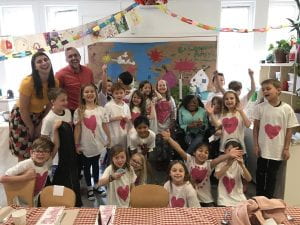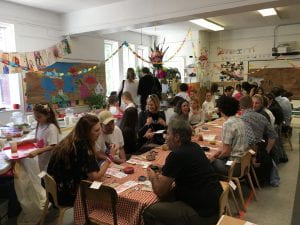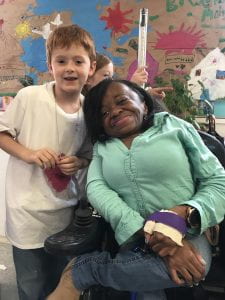Essential Questions:
- How do people help in a community?
- Who do we think needs help in a community?
- Who are the helpers we do not see?
- How can I use my voice to raise awareness of issues that matter to me?
Reflective Practice:
In the first grade classroom, we frame the year as an exploration of our community — What does a community ‘need’ vs. what does a community ‘want’? How are the needs of safety, food, learning, and recreation met? We spend a lot of time exploring and defining for ourselves what the word community means and how each individual is essential for the unique skills and perspectives they bring to the group. We read Swimmy, The Colors of Us, and I Am Jazz. We talk about the different people who help our neighborhood and the tools they use to do their jobs. And, until recently, we always do the First Grade Restaurant.

While the children undeniably look forward to and enthusiastically embark on the restaurant project, I began to feel that it was more of a performance for parents with a focus on big tips and titles with
only a cursory thought to the charitable donation than a communal experience that contributed to our community or challenged our thinking in any meaningful, enduring way. Last year, desperate for a way out of the grade-level expectation, I followed the first graders’ lead as we opened a snack stand that operated on a cycle of love—where a snack made with care could be exchanged for a handmade piece of heartwork which was then redistributed throughout our c
ommunity. The first graders’ experience of voluntarily making something that was accessible to and shared by all inspired a larger group effort.
 Connected to the work of organizations we’d learned about in our visits around the neighborhood (The Bowery Mission, God’s Love We Deliver, and Adaptive Design) first graders decided to put their efforts into planning and hosting an Empty Bowls fundraising event. They created hand-made ceramic bowls and then invited parents and neighbors to purchase the bowls for a suggested donation. The bowls were then filled with a delicious soup or salad that the first graders made themselves. As the diners enjoyed their meals, first graders presented information on the organizations they’d learned about. They used their voices to amplify the work these organizations do and shared how they felt this work was important to the community. Diners were encouraged to make additional donations if they were able, and a few even became volunteers themselves. The children raised over $500.
Connected to the work of organizations we’d learned about in our visits around the neighborhood (The Bowery Mission, God’s Love We Deliver, and Adaptive Design) first graders decided to put their efforts into planning and hosting an Empty Bowls fundraising event. They created hand-made ceramic bowls and then invited parents and neighbors to purchase the bowls for a suggested donation. The bowls were then filled with a delicious soup or salad that the first graders made themselves. As the diners enjoyed their meals, first graders presented information on the organizations they’d learned about. They used their voices to amplify the work these organizations do and shared how they felt this work was important to the community. Diners were encouraged to make additional donations if they were able, and a few even became volunteers themselves. The children raised over $500.
This certainly felt like a more organic, responsive, and responsible iteration of what has come to be a first grade tradition. Too, the experience appears to have been meaningful and memorable for the children. I feel we were able to support the children as they identified imbalances in our community and to help them discover that their voices can be used to raise the visibility and improve the experiences of their neighbors. However, I think there is still much more work to do to build a truly anti-bias curriculum, and I am left with ever more questions: How do I bravely bring conversations about the systemic racism and classism that allows for unequal access to basic resources? [How do I lead discussions that confront a culture that is shaped around the able-bodied, for example helping the students get to know the neighbors who aren’t able to leave their homes?] How can we feel empowered to make the changes we want to see instead of allowing ourselves to become dehumanized as we learn, internalize, and accept injustice? How do we not only sing the song “What Can One Little Person Do?”, but how can we bring that song to loud, vibrant, and world-changing life?
 These final questions made me realize that an important aspect of my curriculum was and still is missing: conversations about injustices at a six and seven year old level that inspire some of the activism they are so eager to do. Equally important was my role in the equation. If I aspire to be an anti-bias educator, how do I hold myself accountable and name my whiteness, my able-bodiedness, my socio-economic status? What are ways I model, daily, a willingness to not just name/notice the bias within myself and the world around me but to, in every moment, be willing to actively do the work against it? These reflective questions are harder to address in my curriculum than I thought. Onward is my only choice.
These final questions made me realize that an important aspect of my curriculum was and still is missing: conversations about injustices at a six and seven year old level that inspire some of the activism they are so eager to do. Equally important was my role in the equation. If I aspire to be an anti-bias educator, how do I hold myself accountable and name my whiteness, my able-bodiedness, my socio-economic status? What are ways I model, daily, a willingness to not just name/notice the bias within myself and the world around me but to, in every moment, be willing to actively do the work against it? These reflective questions are harder to address in my curriculum than I thought. Onward is my only choice.


Sarah, I’m struck by the power and possibility that comes from the simple act of interrogating tradition. I suspect that the First Grade restaurant project resonated differently for the teachers who originally created it. As we move further from that moment and one where other teachers are continuing a tradition, it’s possible that we can lose sight of the original intent. In a way, I think this also resonates with Stevenson’s notion of the need for proximity. If we look deeply at the curriculum, it’s likely that there are many places where we’ve drifted form the core of what created many of these curricular keystone moments. So it seems like the questions that you are asking here are asking us to get proximate to the core ideas that are central to our progressive practice and in a more literal sense to design learning experience that gets students more proximate to issues, communities and individuals who are engaged in equity and social justice work. It strikes me that the Teaching Tolerance standards offer some crucial orienting points for figuring out how to get learners at different developmental stages more proximate to the experiences that will support their ongoing growth and learning. In the process, we’ll build some new traditions for future generations of teachers to interrogate and then iterate on. Thanks for pushing LREI forward.